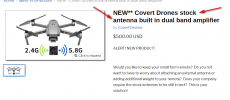I just checked the Covert Drones website ... I didn't even have to call them. They get almost all of their actual receive gain FROM THE EXTERNAL ANTENNA! They have the plots and specs that show it. The antenna gives either 10 dBi or 12dBi gain depending on the band, but we're not talking simply an amplifier in the RC like other posters here seem to have thought. Yes ... they have an amplifier for receive as well as for transmit, but I guarantee that the antenna is doing all of the real work for receive since the receive amplifier would be amplifiying incoming noise as well as signal. The only way that the receive amplifier would make a significant difference is if the receive amplifier has a lower noise figure (the noise it creates itself) than the receive input of the stock controller does ... which I find unlikely.
It's obvious that this thread has mashed up more than one approaches to these range extenders and that has made things confusing. One outfit puts amplifiers in both the drone and the controller, and the other uses a combination of gain antennas and amplifiers only at the controller, but the bottom line is that a transmit-only amplifier in the controller without any external gain antenna doesn't make physical sense like some here have claimed.
It's obvious that this thread has mashed up more than one approaches to these range extenders and that has made things confusing. One outfit puts amplifiers in both the drone and the controller, and the other uses a combination of gain antennas and amplifiers only at the controller, but the bottom line is that a transmit-only amplifier in the controller without any external gain antenna doesn't make physical sense like some here have claimed.










